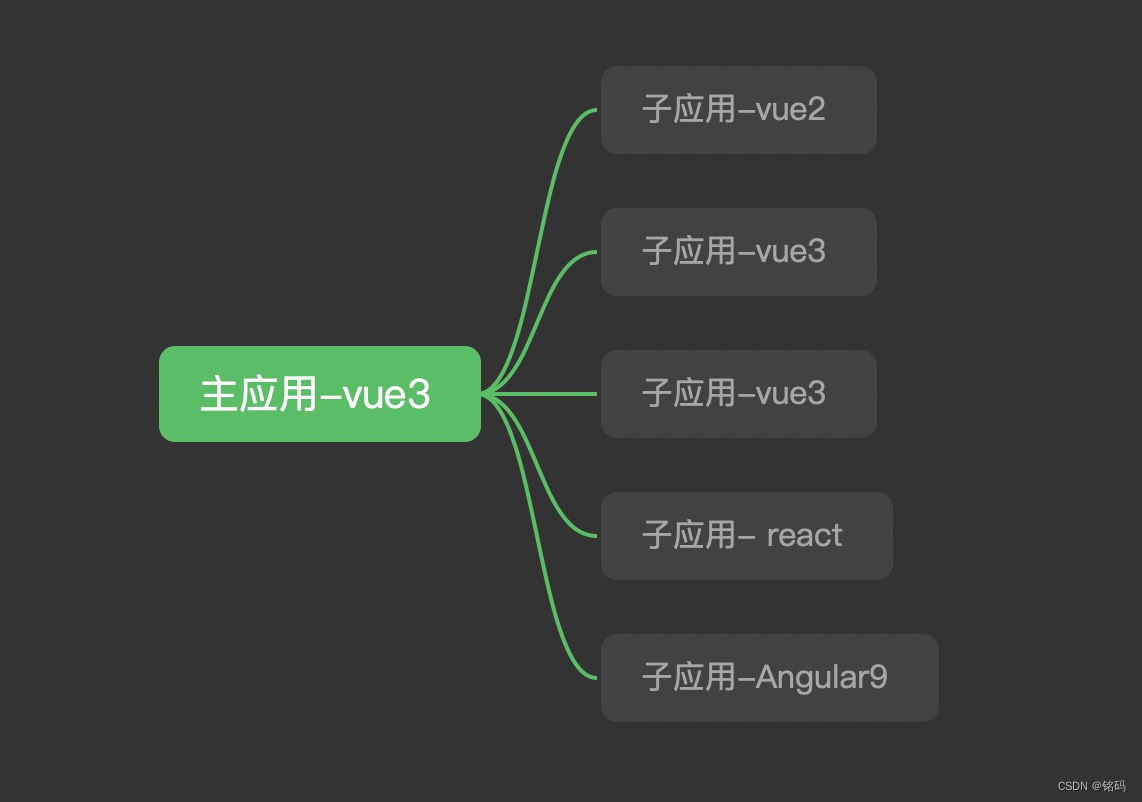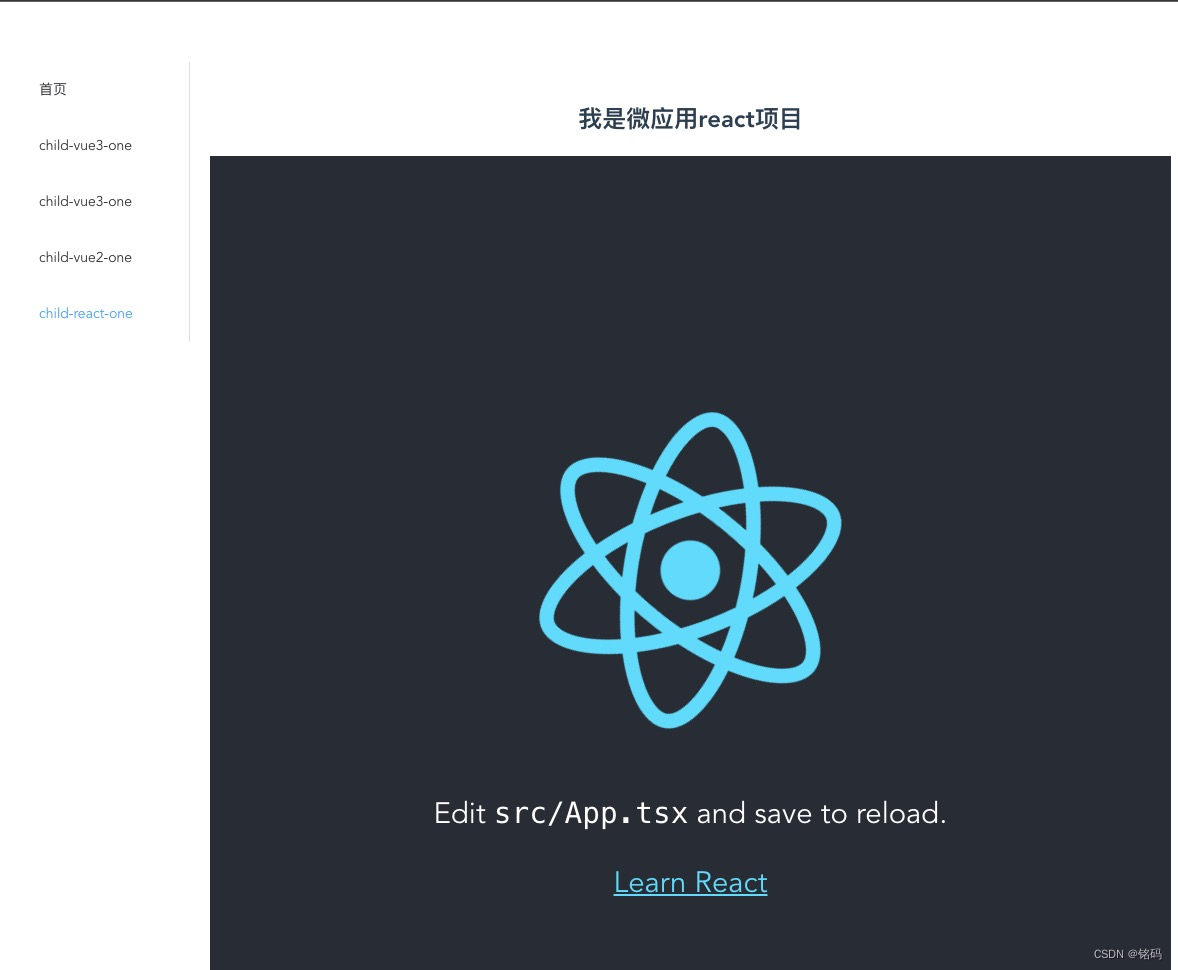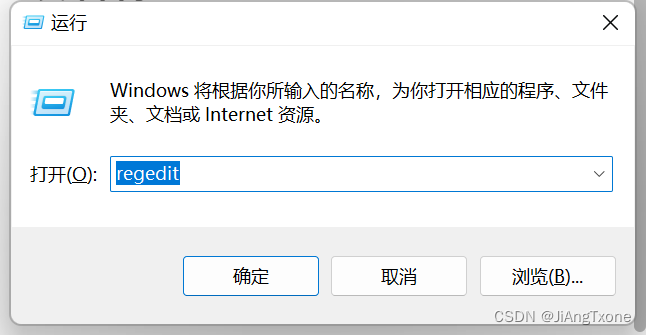本文章介绍了qiankun在vue3的应用,其中子应用有vue2、vue3、react、angular
介绍
qiankun 是一个基于 single-spa 的微前端实现库,旨在帮助大家能更简单、无痛的构建一个生产可用微前端架构系统。
其他几款([single-spa]、[micro-app]、[百度emp]])
使用 iframe 整合系统时,假设我们有系统 A, 当我们想把系统 B 引入 A 系统时,只需要 B 系统提供一个 url 给 A 系统引用即可,这里我们把 A 系统叫做父应用,把 B 系统叫做子应用。同样的,微前端也延续了这个概念,微前端在使用起来基本和使用 iframe 一样平滑。
结构
主应用(父),微应用(子)

案例
一、主应用
- 主应用不限技术栈,只需要提供一个容器 DOM,然后注册微应用并 start 即可。
创建主应用项目 -vue3
npm install @vue/cli -g
vue create qiankun-tast
- 在主应用中安装qiankun框架
$ yarn add qiankun # 或者 npm i qiankun -S
- 在 主应用 中注册微应用
main.js:
import { createApp } from 'vue'
import App from './App.vue'
import router from './router/index'
import ElementPlus from 'element-plus'
import 'element-plus/dist/index.css'
import 'zone.js';
import { registerMicroApps } from 'qiankun';
registerMicroApps([
// {
// name: "vue2App",
// props: { age: 10 }, //给子应用传数据
// entry: "//localhost:3001", //默认会加载这个html,解析里面的js,动态执行(子应用必须支持跨域)里面,是用fetch去请求的数据
// container: "#out-main", //挂载到主应用的哪个元素下
// activeRule: "/vue2", //当我劫持到路由地址为/vue2时,我就把http://localhost:3000这个应用挂载到#app-main的元素下
// },
{
name: "vueChildOne",
entry: "//localhost:3001",
container: "#child-vue3-one-content",
activeRule: "/child-one",
},
{
name: "vueChildTwo",
entry: "//localhost:3002",
container: "#child-vue3-two-content",
activeRule: "/child-two",
},
{
name: "vue2Child",
entry: "//localhost:3003",
container: "#child-vue2-one-content",
activeRule: "/child-vue2-one",
},
{
name: "reactApp1",
entry: "//localhost:4001",
container: "#child-react-one-content",
activeRule: "/child-react-one",
},
{
name: "angularApp1",
entry: "//localhost:4200",
container: "#child-angular-one-content",
activeRule: "/child-angular-one",
},
]);
// setDefaultMountApp('/child-one')
// 启动 qiankun
// start();
createApp(App).use(ElementPlus).use(router).mount('#app-base')
App.vue
<template>
<div class="common-layout">
<el-container>
<el-aside width="200px">
<el-menu>
<el-menu-item index="1">
<el-icon><icon-menu /></el-icon>
<span @click="goHome">首页</span>
</el-menu-item>
<el-menu-item index="2">
<el-icon><icon-menu /></el-icon>
<span @click="$router.push('/child-one')">child-vue3-one</span>
</el-menu-item>
<el-menu-item index="3">
<el-icon><document /></el-icon>
<span @click="$router.push('/child-two')">child-vue3-one</span>
</el-menu-item>
<el-menu-item index="4">
<el-icon><document /></el-icon>
<span @click="$router.push('/child-vue2-one')">child-vue2-one</span>
</el-menu-item>
<el-menu-item index="5">
<el-icon><document /></el-icon>
<span @click="$router.push('/child-react-one')">child-react-one</span>
</el-menu-item>
<el-menu-item index="6">
<el-icon><document /></el-icon>
<span @click="$router.push('/child-angular-one')">child-angular-one</span>
</el-menu-item>
</el-menu>
</el-aside>
<el-main> <router-view></router-view></el-main>
</el-container>
</div>
</template>
<script>
export default {
name: "App",
components: {},
methods: {
// 跳转页面方法
goHome() {
this.$router.push("/");
},
},
};
</script>
<style>
.bens {
width: 100%;
display: flex;
justify-content: center;
position: absolute;
top: 15px;
left: 0;
z-index: 9999999;
}
#app-base {
font-family: Avenir, Helvetica, Arial, sans-serif;
-webkit-font-smoothing: antialiased;
-moz-osx-font-smoothing: grayscale;
text-align: center;
color: #2c3e50;
margin-top: 60px;
}
</style>
index.html:
// 将id:app 改为 app-base 自定义就行,只要与main.js对应起来,切不与微应用重复
<div id="app-base"></div>
router.js
import { createRouter, createWebHistory } from "vue-router";
// 2. 配置路由
const routes = [
{
path: "/",
name: "home",
component: () => import("@/views/home/index.vue"),
},
{
path: "/child-one",
component: () => import("@/views/childOne/index.vue"),
},
{
path: "/child-two",
component: () => import("@/views/childTwo/index.vue"),
},
{
path: "/child-vue2-one",
component: () => import("@/views/childVue2One/index.vue"),
},
{
path: "/child-react-one",
component: () => import("@/views/childReactOne/index.vue"),
},
{
path: "/child-angular-one",
component: () => import("@/views/childAgOne/index.vue"),
},
];
// 1.返回一个 router 实列,为函数,里面有配置项(对象) history
const router = createRouter({
mode: 'history',
history: createWebHistory(),
routes,
});
// 3导出路由 然后去 main.ts 注册 router.ts
export default router
vue3子应用
- 创建项目
// 选择vue3这个版本
vue create child-one
-
在 src 目录新增 public-path.js
-
解决静态文件跨域
// src/public-path.js
if(window.__POWERED_BY_QIANKUN__) {
__webpack_public_path__ = window.__INJECTED_PUBLIC_PATH_BY_QIANKUN__;
}
- 修改路由文件,建议使用history 模式的路由,并设置路由 base,值和它的 activeRule 是一样的。
import { createRouter, createWebHashHistory, createWebHistory } from "vue-router";
// 2. 配置路由
const routes = [
{
path: '/',
component: () => import('@/views/home/index.vue'),
},
{
path: '/about',
component: () => import('@/views/about/index.vue'),
},
];
// 1.返回一个 router 实列,为函数,里面有配置项(对象) history
const router = createRouter({
mode: 'history',
base: window.__POWERED_BY_QIANKUN__ ? "/child-one" : "/",
history: createWebHashHistory('/child-one'),
routes,
});
// 3导出路由 然后去 main.ts 注册 router.ts
export default router
- 入口文件 main.js 修改,为了避免根 id #app 与其他的 DOM 冲突,需要限制查找范围。并导出三个生命周期函数。
import { createApp } from 'vue'
import App from './App.vue'
import router from './router/index'
import './public-path'
// createApp(App).mount('#app')
let instance = null;
function render(props = {}) {
if (instance) return;
const { container } = props;
console.log(container);
instance = createApp(App)
.use(router)
.mount(container ? container.querySelector("#app-child-one") : "#app-child-one");
}
// 独立运行时
if (!window.__POWERED_BY_QIANKUN__) {
render();
}
export async function bootstrap() {
console.log("[vue] vue app bootstraped");
}
export async function mount(props) {
console.log("[vue] props from main framework", props);
render(props);
}
export async function unmount() {
//可选链操作符
instance.$destroy?.();
instance = null;
}
- 主应用容器子应用
qiankun-test/src/views/childOne/index.vue
<template>
<h2>我是子应用 vue3-one</h2>
<div id="child-vue3-one-content"></div>
</template>
<script>
import { start } from "qiankun";
export default {
name: "childOne",
components: {},
mounted() {
if (!window.qiankunStarted) {
window.qiankunStarted = true;
start();
}
},
};
</script>
<style>
</style>
运行效果如下:

vue2子应用-child-vue2

childVue2One/index.vue
<template>
<h2>我是微应用vue2项目</h2>
<div id="child-vue2-one-content"></div>
</template>
<script>
import { start } from "qiankun";
export default {
name: "vueChild",
components: {},
mounted() {
this.$nextTick(() => {
if (!window.qiankunStarted) {
window.qiankunStarted = true;
start();
}
});
},
};
</script>
<style>
</style>
- 微应用配置child-vue2
src下创建public-path.js
if (window.__POWERED_BY_QIANKUN__) {
__webpack_public_path__ = window.__INJECTED_PUBLIC_PATH_BY_QIANKUN__
}
main.js
// src/main.js
import Vue from 'vue'
import App from './App'
import router from './router'
import "./public-path";
Vue.config.productionTip = false
// 定义一个Vue实例
let instance = null
// 渲染方法
function render(props = {}) {
const { container } = props
instance = new Vue({
router,
render: (h) => h(App)
}).$mount(container ? container.querySelector('#app'): '#app')
}
// 独立运行时
if(!window.__POWERED_BY_QIANKUN__) {
render()
}
//暴露主应用生命周期钩子
/**
* bootstrap : 在微应用初始化的时候调用一次,之后的生命周期里不再调用
*/
export async function bootstrap() {
console.log('vue2-app bootstraped');
}
/**
* mount : 在应用每次进入时调用
*/
export async function mount(props) {
console.log('vue2-app mount', props);
render(props);
}
/**
* unmount :应用每次 切出/卸载 均会调用
*/
export async function unmount() {
console.log("vue2-app unmount")
instance.$destroy();
instance.$el.innerHTML = '';
instance = null;
}
vue.config.js
module.exports = {
lintOnSave: false,
devServer: {
port: "3003",
headers: {
"Access-Control-Allow-Origin": "*", //所有人都可以访问我的服务器
},
},
configureWebpack: {
output: {
// library: `${name}-[name]`,
library: `vueChildOne`,
libraryTarget: "umd", // 把微应用打包成 umd 库格式
// jsonpFunction: `webpackJsonp_${name}`,
},
},
};
router.js
import { createRouter, createWebHashHistory, createWebHistory } from "vue-router";
// 2. 配置路由
const routes = [
{
path: '/',
component: () => import('@/views/home/index.vue'),
},
{
path: '/about',
component: () => import('@/views/about/index.vue'),
},
];
// 1.返回一个 router 实列,为函数,里面有配置项(对象) history
const router = createRouter({
mode: 'history',
base: window.__POWERED_BY_QIANKUN__ ? "/child-one" : "/",
history: createWebHashHistory('/child-one'),
routes,
});
// 3导出路由 然后去 main.ts 注册 router.ts
export default router
vue2错误问题
路由版本不对

下载指定版本在3*的就行
react子应用

问题
- 当修改入口文件index.tsx之后,主要是添加了qiankun的生命周期之后,报错
– You need to export lifecycle functions in reactApp1 entry
明明我已经写了生命周期但是没有生效。
问题出在:官方问题使用的js语法,我使用的是ts语法。
解决:用react-app-rewired方案复写webpack就可以了。作用:通过react-app-rewired插件,react-app-rewired的作用就是在不eject的情况下,覆盖create-react-app的配置.
angular子应用
angular由于在国内用的不多所以我是按照官方教程完成的,当然中间出了很多狗血的错误
官方:以 Angular-cli 9 生成的 angular 9 项目为例,其他版本的 angular 后续会逐渐补充。
这句话就是一个坑,首先我自己原有的angular版本是12,用 ng 命令安装的项目就是最新的了。这个导致我安装官方操作一直没有成功,不断报错。------我放弃了,做个乖孩子,用angular9
由于不能降低电脑全局版本,于是我在本项目中安装了一个angular-cli9
npm install @angular/cli@9.0.1
ng new child-angular1
版本搞成了9那就好办了
- 根据要求配置好主应用的main.js与App.vue文件
- 在主应用views创建anguale的容器.vue文件
- 配置主应用路由
- 然后就是根据qiankun的文档配置文件了
注意:在qiankun的文档中第二步,child-angular-one这个是和主应用配置路由一致
设置 history 模式路由的 base,src/app/app-routing.module.ts 文件:文章来源:https://uudwc.com/A/R6grp
import { NgModule } from '@angular/core';
import { Routes, RouterModule } from '@angular/router';
import { APP_BASE_HREF } from '@angular/common';
const routes: Routes = [];
@NgModule({
imports: [RouterModule.forRoot(routes)],
exports: [RouterModule],
// @ts-ignore
// child-angular-one 必须和主路由向对应
providers: [{ provide: APP_BASE_HREF, useValue: window.__POWERED_BY_QIANKUN__ ? '/child-angular-one' : '/' }]
})
export class AppRoutingModule { }
gitee地址:qiankun-vue3文章来源地址https://uudwc.com/A/R6grp
